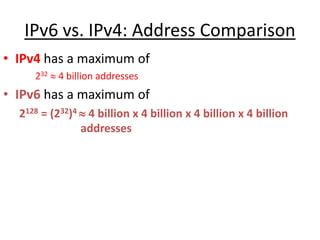Classless inter domain routing
- 2. 2 Address Allocation Problem • Exhaustion of the class B network address space • The lack of a network class of size which is appropriate for mid-sizes organization – class C, with a max of 254 hosts, too small – While class B, with a max of 65534 hosts, too large • Allocate block of class C instead and downside is more routes entry in routing table
- 3. CIDR - Classless Interdomain Routing • Goals: – Restructure IP address assignments to increase efficiency – Hierarchical routing aggregation to minimize route table entries Key Concept: The length of the network id (prefix) in IP addresses is arbitrary/flexible and is defined by the network hierarchy. • Consequence: – Routers use the IP address and the length of the prefix for forwarding. – All advertised IP addresses must include a prefix
- 4. CIDR Example • CIDR notation of a network address: 192.0.2.0/18 • "18" says that the first 18 bits are the network part of the address • The network part is called the network prefix • Example: – Assume that a site requires an IP network domain that can support 1000 IP host addresses – With CIDR, the network is assigned a continuous block of 1024 = 210 (>1000) addresses with a 32-10 = 22-bit long prefix
- 5. IPv6 vs. IPv4: Address Comparison • IPv4 has a maximum of 232 4 billion addresses • IPv6 has a maximum of 2128 = (232)4 4 billion x 4 billion x 4 billion x 4 billion addresses
- 6. Notation of IPv6 addresses • Convention: The 128-bit IPv6 address is written as eight 16-bit integers (using hexadecimal digits for each integer) CEDF:BP76:3245:4464:FACE:2E50:3025:DF12 • Short notation: • Abbreviations of leading zeroes: CEDF:BP76:0000:0000:009E:0000:3025:DF12 CEDF:BP76:0:0:9E :0:3025:DF12 • “:0000:0000” can be written as “::” CEDF:BP76:0:0:FACE:0:3025:DF12 CEDF:BP76::FACE:0:3025:DF12 • IPv6 addresses derived from IPv4 addresses have different formats. Convention allows to use IPv4 notation for the last 32 bits. 128.143.137.144 -> 0:0:0:0:0:ffff:808F:8990 or 128.143.137.144 -> 2002:808f:8990:0:0:0:0:0 (called 6to4 address)
- 7. IPv6 Provider-Based Addresses • The first IPv6 addresses will be allocated to a provider- based plan • Type: Set to “010” for provider-based addresses • Registry: identifies the agency that registered the address The following fields have a variable length (recommeded length in “()”) • Provider: Id of Internet access provider (16 bits) • Subscriber: Id of the organization at provider (24 bits) • Subnetwork: Id of subnet within organization (32 bits) • Interface: identifies an interface at a node (48 bits) Registry ID Provider ID 010 Subscriber ID Interface ID Subnetwork ID
- 8. More on IPv6 Addresses • The provider-based addresses have a similar flavor as CIDR addresses • IPv6 provides address formats for: – Unicast – identifies a single interface – Multicast – identifies a group. Datagrams sent to a multicast address are sent to all members of the group – Anycast – identifies a group. Datagrams sent to an anycast address are sent to one of the members in the group.
- 10. 11 Hop-by-Hop Packet Forwarding • Each router has a forwarding table – Maps destination addresses… – … to outgoing interfaces • Upon receiving a packet – Inspect the destination IP address in the header – Index into the table – Determine the outgoing interface – Forward the packet out that interface • Then, the next router in the path repeats – And the packet travels along the path to the destination
- 11. 12 Separate Entry Per 24-bit Prefix • If the router had an entry per 24-bit prefix – Look only at the top 24 bits of the destination address – Index into the table to determine the next-hop interface host host host LAN 1 ... host host host LAN ... router router router WAN WAN 1.2.3.4 1.2.3.7 1.2.3.156 5.6.7.8 5.6.7.9 5.6.7.212 1.2.3.0/24 5.6.7.0/24 forwarding table
- 12. 13 Separate Entry Classful Address • If the router had an entry per classful prefix – Mixture of Class A, B, and C addresses – Depends on the first couple of bits of the destination • Identify the mask automatically from the address – First bit of 0: class A address (/8) – First two bits of 10: class B address (/16) – First three bits of 110: class C address (/24) • Then, look in the forwarding table for the match – E.g., 1.2.3.4 maps to 1.2.3.0/24 – Then, look up the entry for 1.2.3.0/24 – … to identify the outgoing interface
- 13. Longest Prefix Match Forwarding • Forwarding tables in IP routers – Maps each IP prefix to next-hop link(s) • Destination-based forwarding – Packet has a destination address – Router identifies longest-matching prefix – Cute algorithmic problem: very fast lookups 4.0.0.0/8 4.83.128.0/17 201.10.0.0/21 201.10.6.0/23 126.255.103.0/24 201.10.6.17 destination forwarding table Serial0/0.1 outgoing link












